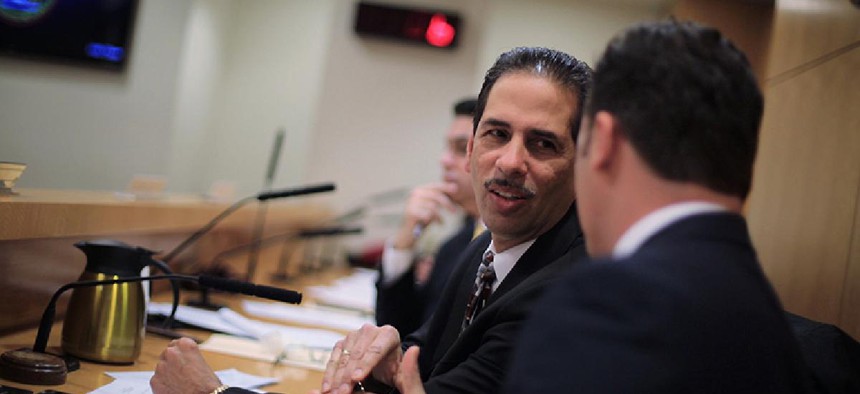In an attempt to reduce recidivism among young offenders, New York City is looking to bolster a program for young people re-entering their communities by building and strengthening partnerships with family members, community-based organizations and the city’s Department of Probation.
New York City’s Close to Home program, which places juveniles in nonprofit residential facilities near their communities as opposed to jails that could be hundreds of miles away from their families, has nearly 250 young people enrolled.
The program, which is overseen by the city’s Administration for Children’s Services, has been lauded by youth justice advocates who say that letting offenders serve time closer to their schools, families and other familiar institutions makes them less likely to commit crimes and gives them the opportunity to gradually reunite with their families.
RELATED: How the ACS measures its providers' performance
“Because juveniles are by nature particularly vulnerable to stress and peer pressure, unless they’re equipped with adequate support networks, it is relatively easy for them to lapse back into the old habits that resulted in the original arrest,” New York City Councilman Fernando Cabrera, chairman of the council’s Juvenile Justice Committee, said in an Oct. 26 committee hearing.
However, the program has had to deal with disturbing failures. Most notably, ACS was forced to retool Close to Home after three 16-year-olds escaped from a Brooklyn group home in June 2015 and raped a woman they met in a Chinatown internet cafe.
Despite the oversight issues highlighted by the incident, the program has been generally well-regarded. Earlier in 2015, a preliminary survey of the program’s results found that the Close to Home program is a “promising reform” that improved the quality of youth justice in the city and state.
Felipe Franco, the ACS deputy commissioner for the Division of Youth and Family Justice, said at the hearing that judging by data on young people in the program who have made successful transitions to schools and other statistics, “We’re better than we have ever been in the last 15 years.”
As the program that was founded five years ago continues to develop, Franco said the agency wants to improve youth monitoring and accountability by enhancing oversight over staff and providers, and by increasing partnerships.
“Because juveniles are by nature particularly vulnerable to stress and peer pressure, unless they’re equipped with adequate support networks, it is relatively easy for them to lapse back into old habits.” – New York City Councilman Fernando Cabrera
The Close to Home program will soon be matched with the city Department of Probation to use a risk and needs assessment tool to structure improvements for the individual needs of its participants. As an example, youths with “negative peer relationships” will be connected to community-based organizations, such as a YMCA, that will guide them toward youth development activities. Those with family or parenting needs will receive family-based therapy, based on the DOP’s assessment tool.
“As we get better at utilizing that tool that (DOP) uses to assess needs of kids, that will change how we ‘service-plan’ kids. It’ll change how we think about connecting kids to services when they return to the communities,” said John Dixon, associate commissioner for Close to Home.
To help youths reintegrate into society after leaving the group homes, they are referred to a process known as aftercare, in which they are monitored and supervised by ACS placement and permanency specialists who help ensure they don’t fall prey to the negative influences that initially got them into trouble. Some of the aftercare initiatives include peer intervention, employment and Cure Violence programs.
About 181 youths are currently in secure group homes and another 61 are in post-placement aftercare. There is approximately one staffer for every 15 youths in the program, ACS officials said.
Cure Violence programs have begun connecting re-entering youthful offenderswith “interrupters,” people who have often overcome struggles with violence and now serve as role models. The partnership between Close to Home and Cure Violence is still being operated as a pilot, but Franco said the program has surpassed expectations and may be expanded.
RELATED: The best New York City Council members
ACS will also expand family conferencing to ensure a more collaborative planning process for handling disciplinary concerns and helping a young person transition back to their community. Additionally, city agencies that have a stake in juvenile justice – DOP, the Department of Youth and Community Development, the Department of Education and others – will share information to help young adults reacclimate to school and to improve training of Close to Home provider staff.
Their plans follow some recommendations that have been made by providers. Christine Bella, an attorney at the Legal Aid Society, told council members that ACS has addressed concerns about Close to Home and she was encouraged that the program reflected “a major and much-needed transformation in juvenile justice practices.” However, she said there was some need for improvement in the timeliness of referrals from facility placement to outside aftercare programs in order to work out incompatibilities between youths and the programs. She said there also needed to be improvements made to the school re-entry process, such as providing school credit transfers and allowing promotions for overage middle school students involved in the Close to Home program.
Tina Schleicher, a specialist at Children’s Village, which is a Close to Home provider, suggested that families and extended relatives should play a bigger role in youths’ post-incarceration and redemptive paths. “Our focus is really on getting the strengths of the families, setting goals that are designed by the family and using discharge planning that’s going to support their ever-changing circumstances,” she said.


